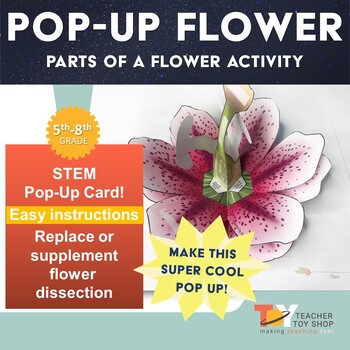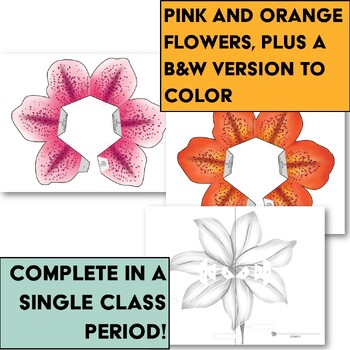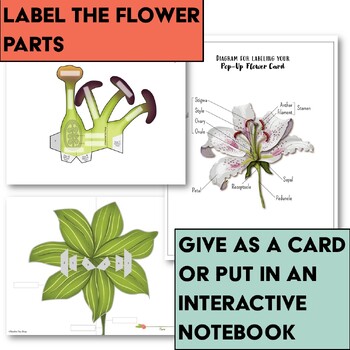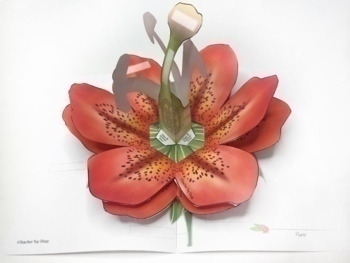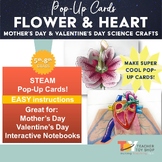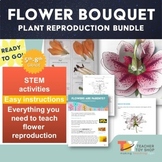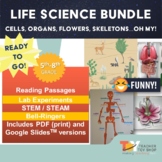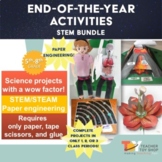Parts of a Flower Hands-On STEAM Activity for science and Mother's Day Craft
- PDF
- Google Apps™
- Easel Activity
- Easel Assessment

What educators are saying
Also included in
- Looking for a SPECTACULAR science project for Mother's Day or Valentine's Day? These will not disappoint! Your students will make a flower popup card and a heart popup card and learn the parts of a flower and parts of the human heart.You can have students label the flower parts or the heart anatomyPrice $8.99Original Price $10.50Save $1.51
- Looking for a comprehensive and engaging bundle to teach all about the parts of a flower? Download Parts of a Flower Unit - Worksheets, Activities, Labs, and More! This all-inclusive bundle is designed to equip educators with everything needed to seamlessly teach flowering plant reproduction, makingPrice $17.99Original Price $28.22Save $10.23
- All of Teacher Toy Shop's Life Science resources in one place! Some biology topics included: cells, ecosystems, human body systems and organs, flowers, reproduction, and more. Includes NGSS aligned lessons, experiments using the Scientific Method, and more.Purchase this bundle for a low-price now, aPrice $49.99Original Price $73.17Save $23.18
- Looking to end the school year with a bang? These WOW end-of-school activities and science projects only require 1, 2, or 3 class periods each to complete. Classroom already packed up? No problem—you need only paper, scissors, glue and/or tape to complete these projects. Keep students engaged and lePrice $20.99Original Price $26.98Save $5.99
Description
Looking for an intriguing educational resource to explore the parts of a flower in a unique way? Download this Parts of a Flower Hands-On STEAM Activity! Perfect for educators seeking an engaging alternative or supplement to live flower dissections, this interactive and artistic project combines science, biology, and creativity to bring the parts of a flower to life in a 3D pop-up card! Plus, this can also be used as an amazingly unique Mother's Day Card.
► Key Features:
- STEAM Integration: Immerse students in a multidisciplinary learning experience that combines Science, Technology, Engineering, Art, and Math.
- Interactive Notebooks: Incorporate the completed pop-up card into an interactive science notebook on flower anatomy, making learning a tangible and memorable experience.
- DIY STEM Spring Craft: Extend the use beyond plant units, making it a perfect DIY STEM spring craft suitable for various occasions and celebrations.
- Quick and Easy: Requires minimal materials—simply print the flower templates, grab scissors and glue, and let the creative learning unfold. Can be completed in just one class period!
► What's Included:
- Printable Flower Templates: Featuring stunning pink and orange stargazer lilies, as well as a black and white version for customization. Ideal for an array of occasions, including Mother's Day, Father's Day, Valentine's Day, or any special celebration!
- Simple Instructions and Video Tutorial: A 3-step guide to effortlessly create the flower pop-up card, complemented by a video tutorial for visual learners. Seamless integration with distance learning or remote teaching.
- Digital EASEL Activity: Enhance understanding with a digital version of the instructions, complete with a labeled diagram of the flower's anatomy. Perfect for interactive notebooks or digital assignments.
- Parts of the Flower Diagram: Detailed instructions for labeling the parts of the flower, reinforcing scientific knowledge while fostering creativity. All answers are included.
- Assessment Exit Ticket: A bonus EASEL assessment with multiple-choice questions and a poll question, allowing you to gauge student comprehension and feedback. Includes audio for accessibility.
- All-Occasion Card Template: Bonus template without blanks for labeling, offering flexibility for creating personalized all-occasion cards.
Ideal for in-class or remote learning environments, Parts of a Flower Hands-On STEAM Activity is a unique STEM project that transforms the study of flower anatomy into a visually stunning and educational masterpiece. Also ideal for scouts flowers badge. It's a totally unique STEM project to build structures. Spark curiosity, foster creativity, and create lasting memories with this hands-on STEAM activity. Download this resource today and watch the learning bloom!
⚠️ BUNDLE & SAVE! ⚠️ Download the complete Parts of a Flower Unit and save on everything you need to teach flower reproduction!
You Might Also Like...
- Parts of a Flower Dissection Science Lab
- Parts of a Flower and Plant Reproduction Activities
- Parts of a Flower and Plant Reproduction Presentation | PowerPoint SLIDES
✪ Don't forget to follow Teacher Toy Shop to be the first to know about new products, sales, and freebies!

